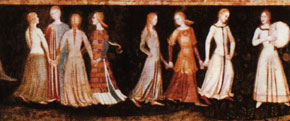Dance in the
15th century
The Sources
Our knowledge of historical dance starts in the 15th century. Under
influence of the Renaissance, manuscripts originated in Italy which make
dance reconstructions possible. These manuscripts were written by dancing masters
for the nobility, with the aim of giving dancing an equal position with arts
such as architecture, music, painting and sculpture. They date, therefore,
from the very origin of dancing as an art form.
An addition 15th century manuscript of great importance comes from Burgundy, and contains no
less than 58 'bassa danse's. The author of this book, which was in the possession of Margaretha
of Austria (1480-1530), is anonymous.
 Surviving dance music from the Middle Ages includes: estampies, saltarello's
and farandole's. Paintings and fresco's show dancing people, often in a
circle or a chain formation. In medieval literature, too, dozens of
indications can be found that dancing took place but, alas, no dance
schema's or choreographies are known to have survived. In practise, this
means that dances from that period cannot be authentically reconstructed.
Surviving dance music from the Middle Ages includes: estampies, saltarello's
and farandole's. Paintings and fresco's show dancing people, often in a
circle or a chain formation. In medieval literature, too, dozens of
indications can be found that dancing took place but, alas, no dance
schema's or choreographies are known to have survived. In practise, this
means that dances from that period cannot be authentically reconstructed.
(For additional information, see: Timothy J. McGee: Medieval Instrumental
dances, Indiana University Press, Bloomington and Indianapolis, 1989)
back | top | next
Ensemble Saltarello | back to index
 Surviving dance music from the Middle Ages includes: estampies, saltarello's
and farandole's. Paintings and fresco's show dancing people, often in a
circle or a chain formation. In medieval literature, too, dozens of
indications can be found that dancing took place but, alas, no dance
schema's or choreographies are known to have survived. In practise, this
means that dances from that period cannot be authentically reconstructed.
Surviving dance music from the Middle Ages includes: estampies, saltarello's
and farandole's. Paintings and fresco's show dancing people, often in a
circle or a chain formation. In medieval literature, too, dozens of
indications can be found that dancing took place but, alas, no dance
schema's or choreographies are known to have survived. In practise, this
means that dances from that period cannot be authentically reconstructed.